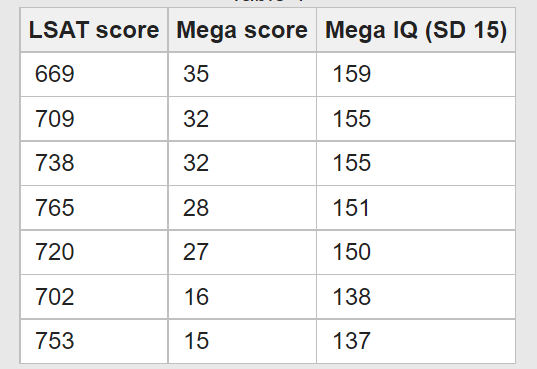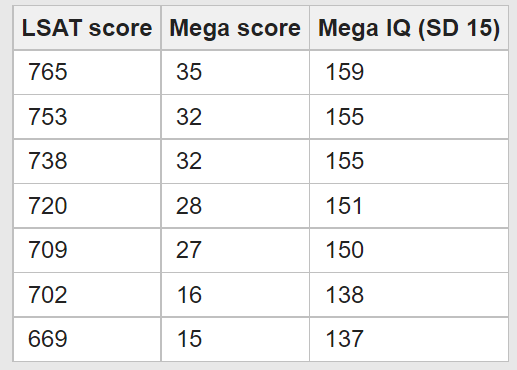I had recently discovered that that people who took both the old GRE and the old SAT (circa 1990) had a verbal old SAT distribution of:
mean: 510.1 (SD = 107.7).
Because the SAT distributions if all 17-year-old Americans had taken the SAT would have been 376 (SD = 102), this implied GRE takers had a mean IQ of 121 (SD = 15.4) (U.S. norms).
Unfortunately this led to ridiculous results like the 95th percentile of the GRE population being at the 99.9 percentile of the general U.S. population. Clearly college admission tests are not normally distributed so we must look at the observed distribution, not the theoretical normal one.
And so I looked at Ron Hoeflin’s Omni sample norming of the Mega Test, where seven Mega Test takers reported scores on the old LSAT.

Then by pairing the Mega and LSAT scores by equal rank in the sample, we get the following equivalencies.

Now to put these numbers in perspective, a 630 was 92nd percentile (among LSAT takers) in 1960 and 725 was the 98th percentile, in 1974 (source: Law School: Legal Education in America from the 1850s to the 1980s, by Robert Bocking Stevens).
From here we might conclude that the 95th percentile of the LSAT population was around 700, which equates to an IQ around 138 (99.5 percentile in the general population). (Note: I’m being 8 IQ points more generous than Mensa, which equates the top 5% of the LSAT population with the top 2% of the U.S. population and thus IQ 130).
This kind of makes sense, because if we assume that roughly 10% of Americans pursue post-grad degrees, and almost 100% of the very brightest do so, then the top 5% of those taking post-grad admission tests should be the top 5%/10 = top 0.5% of Americans as a whole.

i challenge peepee or even of her “genetically superior” peeps…
score high on this without practice/previous exposure.
^^^IMPOSSIBLE^^^
so it was eliminated from the test…what year?
it was just a rubic’s cube solving competition…
STUPID!
my dad is another example of a guy who scored WAY higher when he was 4-5 years older. WAY.
very UN-like steve shoe.
he scored ca. 95th percentile on the SAT.
but the 99th percentile on the LSAT.
or so he told me.
of course this could be because they AREN’T measuring the same thing.
but the LSAT measures more than VIQ.
it’s NOT just verbal.
remember that board game Clue?
he was a total FREAK.
reminded me of what my mom (and her Who’s Who cousin) said about her dad…
total FREAK.
You should convert MPRE and MBE scores to IQ scores…these are achievrment test (law-related) but their correlation with IQ should be high.
I think a gentleman named Joe Separac may have info on this.
In a sample of people who took both the GRE and the SAT (circa 1990), the mean GRE and SAT verbal was 510.1 (SD = 107.7) and 518 (SD of 104.7) respectively.
that means that:
1. the GRE is NOT selective, because 510 should be close to the average of all SAT takers’. how close? the old SAT didn’t have the means of both sections fixed at 500. when they were scores went up by 100 points.
2. graduate school applicants are NOT any smarter than college applicants? another nail in the shoe? sad.
where’s my comment about how chinapipo are inefficient peepee the liar?
https://en.wikipedia.org/wiki/List_of_countries_by_labour_productivity
apparently their “work ethic” is necessary because they’re so inefficient. sad.
1 Ireland
2 Norway
3 Switzerland
4 Luxembourg
5 Denmark
6 United States
7 Netherlands
8 Germany
9 France
10 Belgium
11 Sweden
12 Austria
13 Iceland
14 Australia
15 Finland
16 Canada
17 Spain
18 Italy
19 Singapore
20 United Kingdom
21 Hong Kong
22 Taiwan
23 New Zealand
24 Turkey
25 Japan
26 Slovenia
27 Cyprus
28 Czech Republic
29 Israel
30 South Korea
the GRE is NOT selective, because 510 should be close to the average of all SAT takers’. how close?
No, in 1990 the average verbal SAT was 424 and if all 17-year old Americans had taken it would have been only 376 (SD 102), so the average (verbal) IQ of the SAT population was 107. By contrast a 510 equates to IQ 120, so almost a full SD higher.
the old SAT didn’t have the means of both sections fixed at 500. when they were scores went up by 100 points.
500 and 100 were defined as the mean and SD of WWII SAT takers, for both verbal and math. But as the college bound population became less and less elite, the average slipped to the point where the test had to be re-centred in 1995 to get the means back up to 500 each.
then graduate school applicants are as smart as college applicants used to be? sad.
so what percentile was the average graduate school applicant’s SAT?
Those productivity statistics might as well be made up completely. The way they measure basically measures how much of a tax haven you are. Official GDP is fake news in most countries.
Realistically I’d say Asian countries may be more productive than whites if the asian workers bothered to ask for more of the surplus.
In terms of material productivity, the Asians make more stuff but get crappy terms of trade so they need to work longer to get certain items from the west for various complicated reasons, one of which is Marxist.
that’s only true of ireland. try again.
there’s more to an economy than the intelligence and industry of its individuals or how much quality stuff it makes. and hk and singapore don’t make anything anymore. unlike switzerland. switzerland’s wealth is NOT because if its shady banking sector. this was detailed by ha-joon chang.
a long time ago part of the trade imbalance between the US and japan was due to japan’s very inefficient distribution sector. it had too many middlemen. i’ve also heard it claimed india’s finance sector is much more efficient than china’s.
all of these countries are very densely populated and have little in the way of natural resources. but that’s true of europe too.
Luxembourg, Ireland, Switzerland, Netherlands….these are all tax havens.
Certain states in the US….also tax havens.
HK and Singapore are bordering on the definition of tax haven.
PP did you ever try the Mega Test, or at least some of the problems on it?
no, never
Mugabe probably thinks Asian people have higher IQs than whites because they were raised by jewish mothers.
they have higher PISA scores, but they have a different school system and the ones in the west aren’t representative. so i would not say “they have higher IQs” without qualification, including by the type of IQ est. rr cited evidence they had lower VIQ than whites in america and flynn cited evidence they had lower IQs but did way better at school.
the only thing i’d say without qualification is there is a difference in intelligence profile between chinapipo and caucasians in general, including south asians. they are the same or weaker in VIQ and the same or stronger at non-VIQ. and this is genetic.
We know they have higher IQs because even the peasents they send to the West and raised her are smarter than the white kids.
And the peasents that stayed in East Asia are getting better test results as their nutrition improves. I fully expect China to have a higher IQ than the US after they start giving welfare to their peasent farmers.
Yet another reason why redistribution can be more important than production in economics.
None of the autist academic economists talk about why terms of trade happens. Its like a black hole in trade theory.
Autists assume a commodity is traded for the same value no matter what the participants of the trade are.
We can thank autists for reducing economics to a poor man’s version of applied math.
why does europe get better terms than all the rich chinapipo countries?
if italy is more efficient than singapore imagine how ultra efficient northern italy must be. sad.
did peepee know that “singapore” is a sanskrit word?
Its not that Northern Italy is more efficient than Singapore. Plainly, Singaporeans work harder for less benefits and are probably smarter than most Italians and have more education and more capital per worker.
Its the terms of trade.
Thats the explanation.
Krugman’s theory partially explains it. Basically east asians trade the exact same fridges or microchips or computers to the west for a lower price than if they were made the exact same way in Italy. Krugman basically says its branding and certain status symbol effects of Western goods
I personally would say the Marxist explanation of path dependency is also true. Once youre a colony you basically get worse negotiating terms with capitalists in the West and this stays there for decades. Japanese cars are better than American cars and yet they trade at a discount.
There might even be overt ‘racist’ angles involved.
hoist by your own retard again pill.
another yuge difference between chinapipo and wypipo is wypipo are suspicious of academics.
in america at least there’s a saying “those who can’t do teach.”
in the uk calling someone a “scholar” or a “boffin” is a mild insult.
india is the polar opposite as its highest (but not richest) caste is its academic caste.
but my guess is more indians know school is bullshit than chinapipo.
india loves [deleted by pepee] and [deleted by peepee] love india.
but my guess is more indians know school is bullshit than chinapipo
I wonder how this varies by caste
if ashkenazi jews have been selected for intelligence over the last 1,000 years or whatever…why are they so fucking short?
https://media.gettyimages.com/photos/president-donald-trump-and-ukrainian-president-volodymyr-zelensky-on-picture-id1171051394?s=612×612
Blinken is a jew as well
Because an increase in height doesn’t necessarily entail an increase in intelligence. Regardless of the correlation.
why one may agree with chomsky and chomsky will still label him an “antisemite”.
from kmac and jones…
jews are great critics. the best.
but a man needs to be more than a critic. he needs to DO. TR had a great riff about this quoted by jewish AIG.
can’t find it. second to the ENRON commercials.
in other words, when american society had made all the changes it should make there’d still be jews kveching about something…
and then you think…
what these pipo really want (effectively) is destruction of the good, the beautiful, and the true.
I’m not an expert on currencies or the way the dollar reserve system works but I think this may play a role in terms of trade as well with the dollar basically being used to bludgeon east asians to accept discounts on their goods for hard currency.
geography. and consequent trasportation expense.
all of those rich chinapipo countries are separated by ocean. none share a land border.
this is very unlike europe. and the US and canada together are so yuge they don’t need neighbors.
another cause could be language.
my guess is international trade communications in europe is mostly in english, an indo-european language. chinese, japanese, and korean are totally unrelated languages.
there is not a complete grammar for any (natural) language.
mugabe says: it is HUMANLY impossible to attain native speaker proficiency past the age of 12.
denmark is connected to sweden by bridge. gb to france by chunnel of 50km.
a chunnel from south korea to japan is impossible.
in the late 90s south korea did get raped in the ass by the globalists. pure evil. https://en.wikipedia.org/wiki/South_Korea_and_the_International_Monetary_Fund#The_Asian_Financial_Crisis
plus these countries have developed very quickly/recently.
it may be things like distribution and finance take a long time to get right.
Jews are great critics when they were the working class or refugees.
Then they became neoliberals as soon as they started gathering assets.
Steve Schwarzmann said Obama raising taxes on the rich was like Hitler invading Poland.